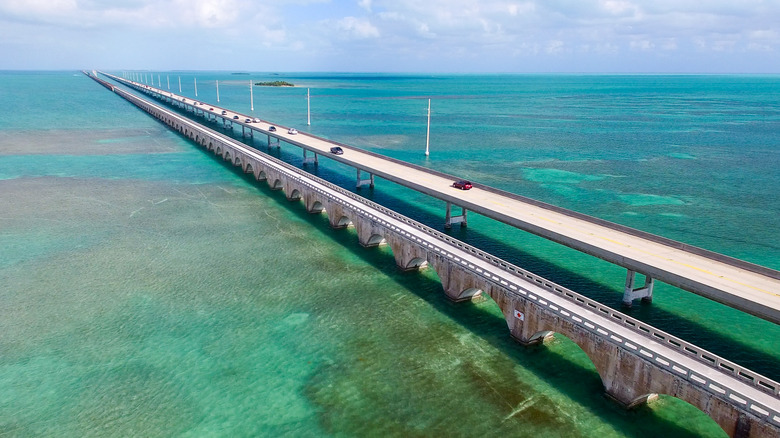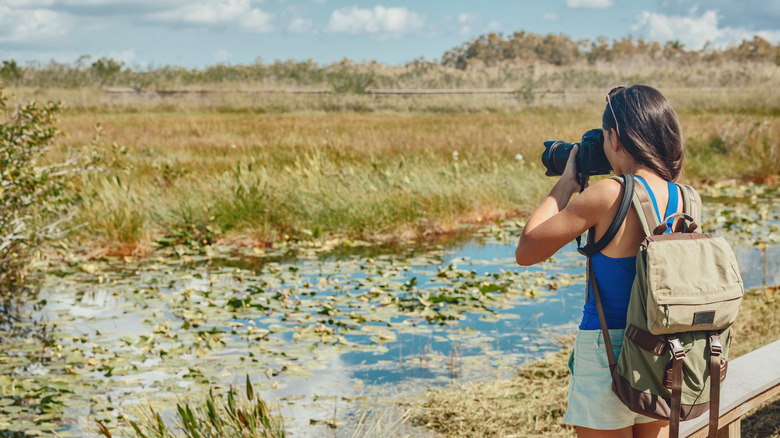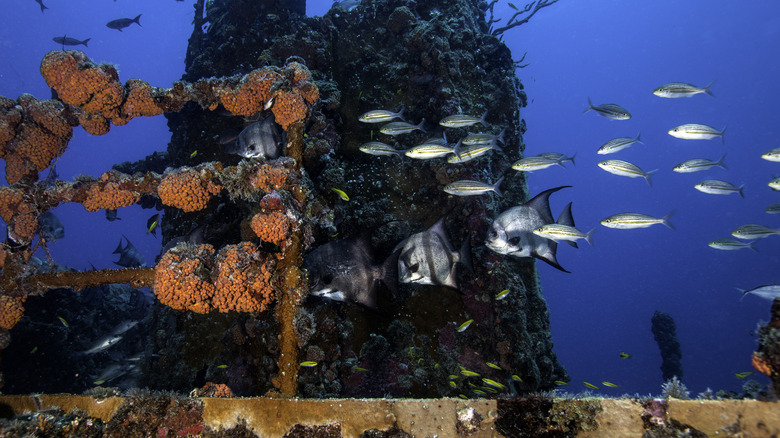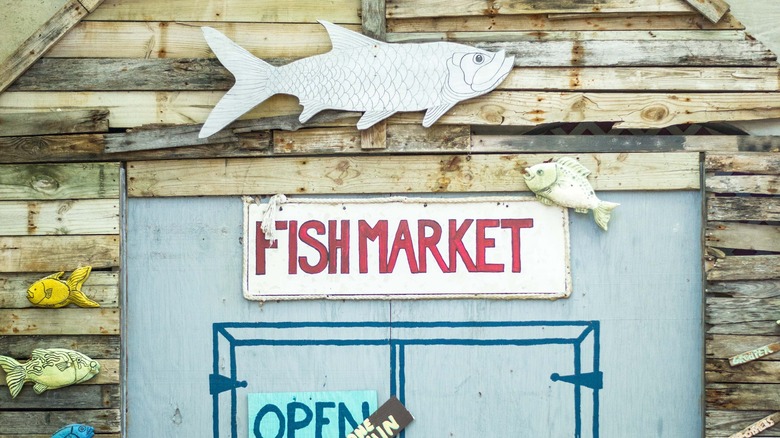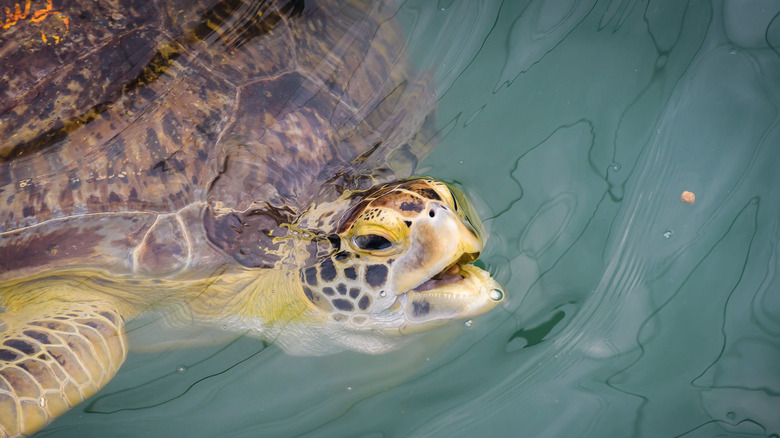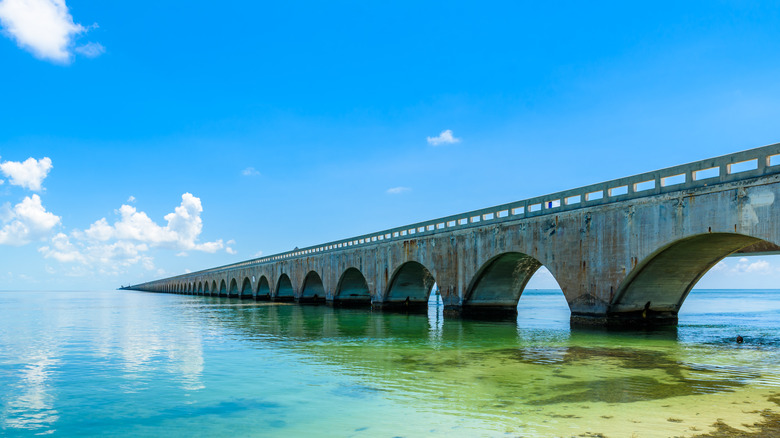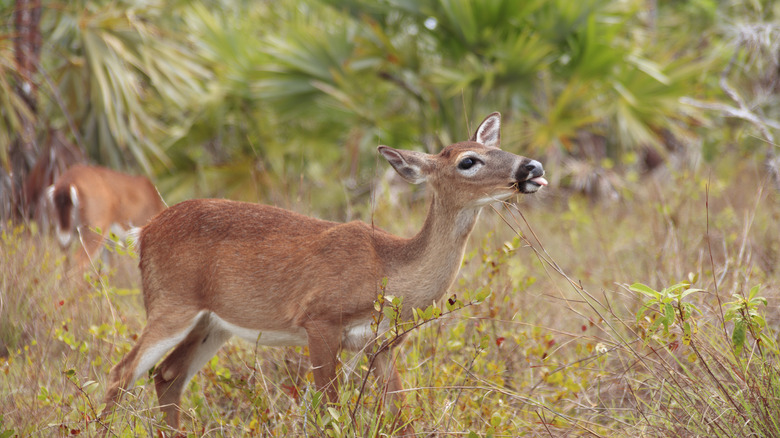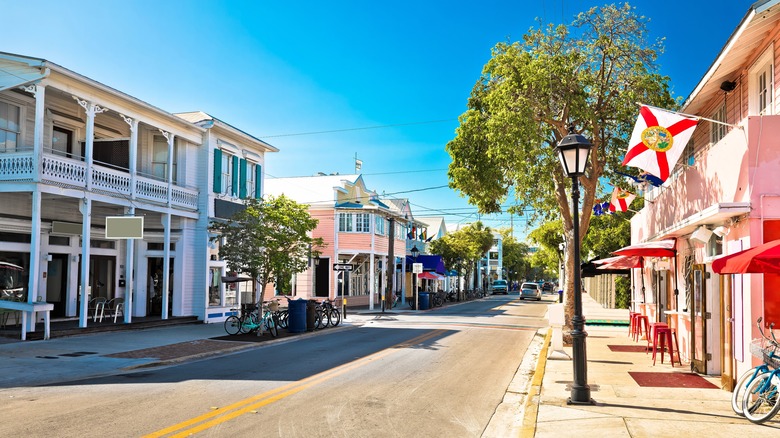Drive Along The Beautiful Florida Coastline On This Popular Road Trip Route
If you are seeking a one-of-a-kind road trip, pack your bags, fill up your tank, and head down south to the Sunshine State. U.S. Route 1 provides unparalleled views of Florida's beautiful Atlantic coastline, easily making it one of America's most scenic highways. The stretch of U.S. Route 1 that runs from Miami to Key West is particularly breathtaking, and cruising down this historic highway is one of the best ways to experience all the beautiful scenery, culture, and activities in South Florida.
This 165-mile drive begins on the coast of Florida's peninsula and winds down through the Florida Keys, which are a chain of 1,700 tropical islands bordered by the Atlantic Ocean to the south and the Florida Bay and Gulf of Mexico to the north. Key Largo, which is the first and longest key in the Florida island chain, is about an hour's drive from Miami. This stretch of U.S. Route 1 that runs from Key Largo to Key West — the key that marks the end of U.S. Route 1 — is commonly referred to as the Overseas Highway.
The spectacular drive from Miami to Key West can take around four hours to complete. While this is easily doable in a day, you should plan for a few extra days to explore the Sunshine State. From nature havens to ocean retreats, here are the South Florida destinations every road tripper should add to their U.S. Route 1 itinerary.
Everglades National Park
Begin your journey on U.S. Route 1 by visiting Everglades National Park — the only subtropical preserve in North America. You can access the Homestead entrance of the park just off US-1 at Florida City. Not only is Everglades National Park the largest designated wilderness area in the eastern United States, but it is also a designated World Heritage Site. Spanning over 1.5 million acres across the Sunshine State, the Everglades is blanketed by sprawling mangroves, sawgrass marshes, and pine flatwoods. This diverse environment is home to hundreds of unique plants and animals, including rare species such as the American crocodile and Florida panther.
There is no shortage of adventures at Everglades National Park. You can hike along numerous trails that weave through the park's wetlands and woodlands, which allows for prime wildlife viewing. If you want to traverse the marshy waters, consider renting a canoe or kayak. Moreover, the park offers ranger-led boat trips and swamp walks, during which you can learn more about the Everglades — and you may even spot some wild American alligators and crocodiles. When visiting the Everglades, be sure to choose eco-friendly activities that help limit your impact on the park's fragile ecosystem.
John Pennekamp Coral Reef State Park
As you venture down to the Florida Keys, you'll pass many different beaches and coastal parks. However, as the United States' first undersea park, John Pennekamp Coral Reef State Park is a bucket list-worthy destination that can't be missed. John Pennekamp Coral Reef State Park is located in Key Largo and encompasses approximately 70 nautical square miles of mangrove swamps, tropical hammocks, and coral reefs. Popular park activities include kayaking, swimming, snorkeling, scuba diving down to shipwreck sites, guided boat tours, and wildlife viewing. While in the area, consider visiting the adjacent Florida Keys National Marine Sanctuary — a protected area where over 6,000 species of marine life reside.
It's important to note that Florida's coral reef has experienced (and is currently experiencing) the harmful impacts of climate change, including coral bleaching from heat stress. Practicing responsible swimming, snorkeling, and diving is an absolute must to protect the environment. Sarah Fangman, a marine scientist and superintendent of Florida Keys National Marine Sanctuary, told NPR that vacationers should try to only book eco-friendly excursions and wear reef-safe sunscreen that contains zinc oxide or titanium dioxide.
Rain Barrel Village
Rain Barrel Village is a detour you can't pass up during your drive, especially if you enjoy shopping, local art, and handmade goods. This open-air complex is in Islamorada — a village encompassing six of the Florida Keys that is located about halfway between Miami and Key West. The galleries at Rain Barrel Village feature work by more than 500 artists, spanning from paintings of native flora and fauna to photography of the serene ocean. Moreover, you can purchase goodies such as candles, hand-crafted jewelry, and custom-scented soaps. After shopping, take a moment to stroll through the colorful gardens that feature eclectic wind chimes and one-of-a-kind art. Need a bite to eat? Enjoy delicious, local fare at the village while listening to live music.
Not to mention at Rain Barrel Village, you'll have the opportunity to meet Betsy the Lobster — a famous 30-foot-high and 40-foot-long sculpture of a Florida Spiny Lobster that can be seen from the Overseas Highway. Many road trippers make sure to snap a photo with this massive crustacean, which captures the creativity at Rain Barrel Village.
The Turtle Hospital
Eco-friendly travelers and animal lovers cannot pass up a trip to The Turtle Hospital in the city of Marathon. The center is a non-profit organization dedicated to the rescue and rehabilitation of endangered sea turtles. To support their mission, The Turtle Hospital offers guided, family-friendly tours that allow visitors to meet their beloved reptile residents. At the facility are sea turtle patients that are being rehabilitated so they can be rereleased into the open ocean, as well as permanent turtle residents that suffered more extreme injuries. Not only will you get a behind-the-scenes look at the hospital's work, but program guests are invited to feed the sea turtles.
The Turtle Hospital is a working veterinary clinic, but it also conducst important marine conservation research that could help save sea turtles across the world. After your tour, you can help support their worthy cause by purchasing a turtle-themed souvenir — or even "adopting" a turtle with a donation to help pay for their care.
Old Seven Mile Bridge
When cruising down the Overseas Highway, consider stopping at the Old Seven Mile Bridge, which is situated at the west end of the city of Marathon. Listed on the National Register of Historic Places, this bridge was originally constructed in the early 1900s as part of a project that aimed to build a railroad from South Florida to Key West. However, it was halted in 1935 when a hurricane destroyed parts of the tracks.
Though driving has not been allowed on the bridge since the 1980s, the Old Seven Mile Bridge continues to be a popular stop for travelers. Even if you're not a history buff, you can enjoy the various walking and biking trails on the bridge. At the end of the Old Seven Mile, visitors will reach the island of Pigeon Key and a famous fishing pier that offers a 360-degree view of the ocean. The bridge divides the Middle Keys from the Lower Keys, meaning that when you reach it, you're around an hour from arriving at Key West.
National Key Deer Refuge
Another destination that is a must-visit for animal lovers is the National Key Deer Refuge in Big Pine Key. While this might not sound all that interesting on the surface, the deer you'll observe at the refuge are not the white-tailed deer you may see in your home state. Rather, Key deer form a small subspecies of white-tailed deer only found in the lower Florida Keys. They are considered endangered, and as of 2023, the current population is estimated to be 700 to 800 deer. The refuge is also home to more than 20 other threatened and endangered plant and animal species.
Once here, you can explore various trails that weave through the refuge's different natural habitats, including pine rockland forests, freshwater wetlands, tropical hardwood hammocks, mangrove forests, and salt marsh wetlands. The Florida Keys is known for its relaxing atmosphere, but touring National Key Deer Refuge truly allows you to slow down, appreciate South Florida's subtropical ecosystems, and get back in touch with nature.
The City of Key West
Your journey down the Overseas Highway comes to an end when you spot the U.S. 1-mile marker zero sign. The historic charm, rich culture, Cuban cuisine, and beautiful ocean views in Key West draw millions of vacationers each year. The city is abundant in activities that are both family-friendly and great for solo or adult travelers. Ocean lovers can spend time on the city's public beaches — including the popular Smathers Beach — and the Clarence S. Higgs Memorial Beach Park. To get a closer look at the island's marine life, consider booking a sustainable nature tour that will take you out onto the ocean waters for dolphin watching or on a responsible snorkeling excursion.
Additionally, for a small entrance fee of $6, history buffs can visit the Fort Zachary Taylor Historic State Park. Here, you can hit the park's beach or stroll the brick corridors of Fort Zachary Taylor, which was used during the Civil War, the Spanish-American War, and both World Wars. The Ernest Hemingway Home and Museum is another special attraction of the town. This preserved estate was once home to American writer Ernest Hemingway in the 1930s and is now well-known for the 60 polydactyl (six-toed) cats that live there. Once the sun goes down, you can revel in Key West's vibrant nightlife scene and even go on an epic bar crawl downtown.
